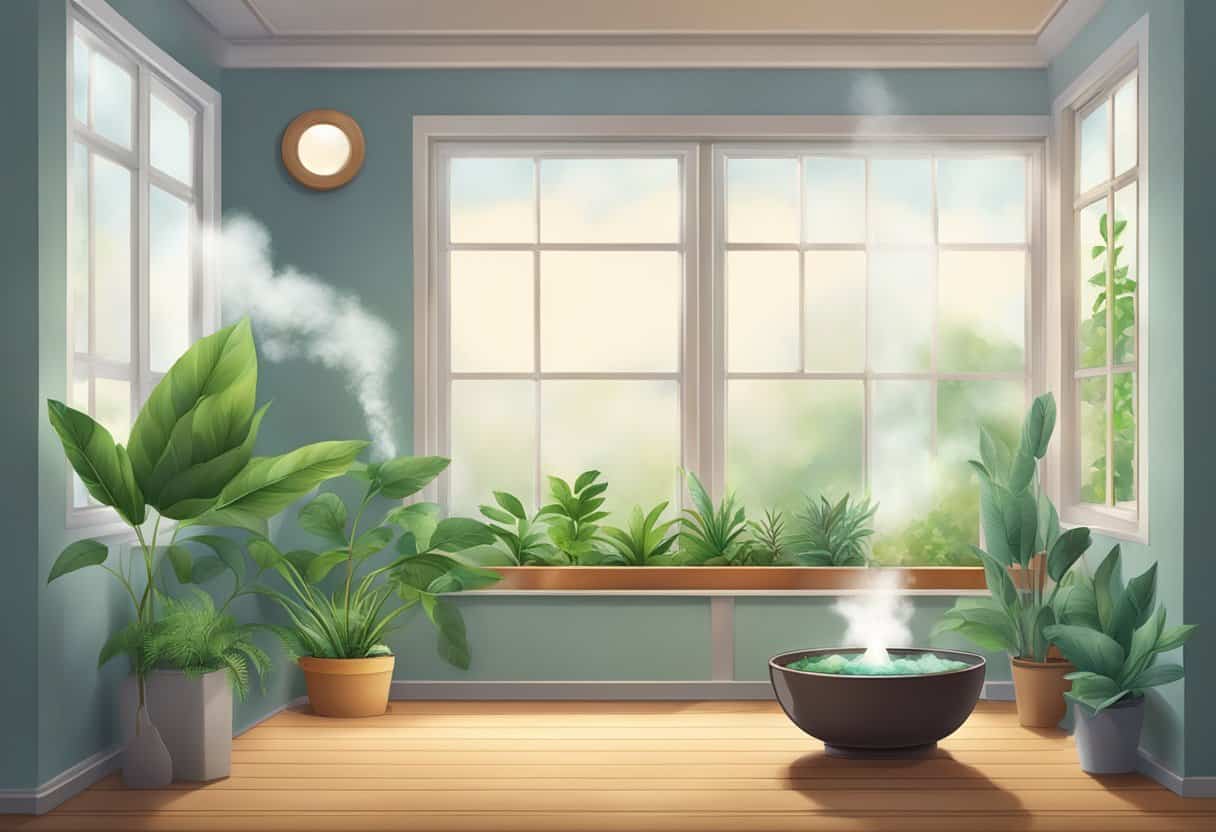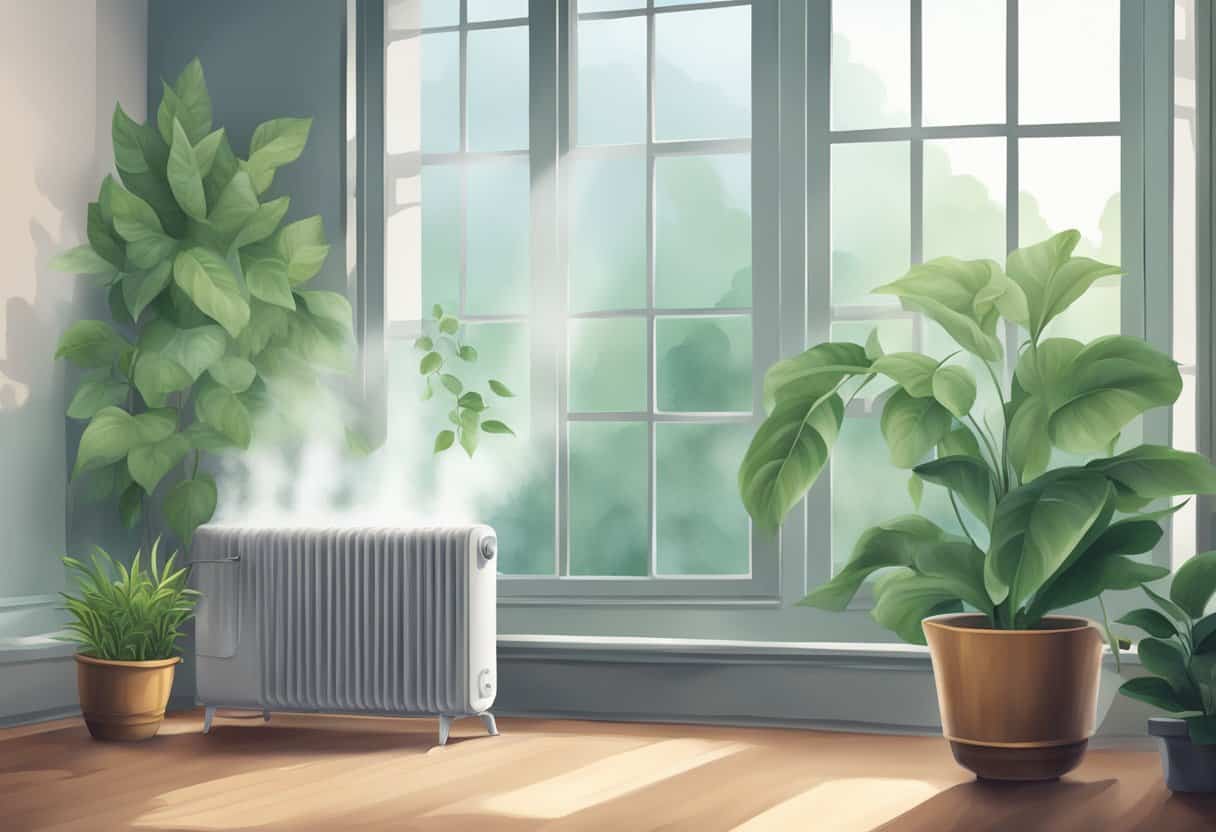Maintaining the right level of humidity in your home is important for both your health and the integrity of your living space.
When the air in your home becomes too dry, it can lead to a variety of discomforts such as dry skin, irritated sinuses, and an increased vulnerability to colds and other respiratory problems. Dry air can also damage woodwork, cause static electricity, and even make it harder to keep your home warm. Fortunately, there are effective ways to increase indoor humidity to create a more comfortable and healthy living environment.
Several natural methods can help to boost humidity at home. These include houseplants that release moisture into the air, bowls of water placed on heating radiators, and simply leaving the bathroom door open when showering to allow steam to disperse.
For more control over humidity levels, mechanical humidifiers range from small units designed for a single room to whole-house systems integrated with your HVAC. Beyond adding moisture to the air, it’s also vital to address any issues that contribute to dryness, such as poor insulation or leaks that let in dry outdoor air.
The best ways to maintain optimal indoor humidity include using humidifiers, incorporating houseplants, and ensuring good home insulation and ventilation. Regularly monitoring with a hygrometer helps maintain healthy levels between 30% and 50%.
Understanding Humidity in Your Home
Maintaining the right level of humidity in your home is essential for your comfort and health. It helps in preventing issues related to dry air and ensures a conducive environment for living.
The Science of Humidity
Humidity refers to the amount of water vapor present in the air. When the air in your home becomes too dry, usually below 30% relative humidity, it can negatively affect various aspects of your indoor environment and personal well-being. An essential point to note is that the optimal humidity levels should be between 30% and 50%. Beyond this range, you may start to encounter problems.
-
Dry Air: Dry air can cause moisture to evaporate from your skin and respiratory system, leading to discomfort and health issues.
-
Wood Damage: Items made from wood, including furniture and musical instruments, can crack or warp when the air is too dry.
-
Health: Low humidity levels have been linked to increased susceptibility to infections as the dry air can impair the body’s respiratory defenses.
Effects of Low Humidity on Health and Comfort
Health Implications
- Skin: Prolonged exposure to low humidity can lead to dryness, flakiness, and irritation of the skin.
- Respiratory Problems: Dry indoor air can exacerbate allergies and asthma, as well as contribute to respiratory infections.
- Dry Eyes and Nosebleeds: Insufficient humidity can lead to irritated eyes and may escalate the frequency of nosebleeds.
Comfort Concerns
- Static Electricity: Dry conditions foster static electricity, which can be a nuisance and even damage electronic devices.
- Indoor Air Quality: Low humidity can also facilitate the survival and spread of some viruses and bacteria, impacting the indoor air quality.
- Houseplants: Many houseplants require sufficient humidity to thrive; otherwise, they can wilt or die, which diminishes indoor air purification.
It’s important to balance humidity levels as excessive moisture may encourage mold and bacteria growth. You should use hygrometers to monitor indoor humidity and employ strategies like humidifiers or houseplants to regulate it effectively. Remember, managing indoor humidity is pivotal for safeguarding both your home’s integrity and your health.
Natural Ways to Increase Humidity
To combat dry air in your home, there are several natural methods that can boost humidity levels. From incorporating houseplants to smartly using daily activities, the following strategies can help you achieve a more comfortable indoor environment.
Utilizing Plants
Houseplants can significantly contribute to the indoor humidity through a process called transpiration. Spider plants and jade plants are known to improve relative humidity due to the release of water vapor from their leaves. Place multiple houseplants around your home, ensuring they receive adequate sunlight; they will not only beautify your space but also act as natural humidifiers.
Leveraging Water Sources
Placing bowls of water near heat sources, such as radiators, can help increase humidity as the heat causes the water to evaporate into the air. Additionally, you can leave the bathroom door open while showering to allow steam to spread to adjacent rooms. This moisture, combined with warm temperatures, can help raise the overall humidity of your home.
Maximizing Daily Activities
Daily household activities can also be harnessed to add moisture to the air. For example, stovetop cooking releases moisture, so opt for this method over using the oven when possible. Similarly, hanging a drying rack in your living space allows clothes to dry naturally, releasing moisture into the air. These simple changes in your routine make the most of activities you’re already doing, benefiting the humidity level of your home.
Mechanical Humidification Methods

When considering mechanical means to raise the humidity in your home, it is vital to select a device that suits your space and to use it correctly to maintain optimal humidity levels without unnecessarily increasing your energy bill.
Choosing the Right Humidifier
To ensure you choose the best humidifier for your needs, you should assess the size of the area you want to humidify. A large humidifier is best for expansive spaces or integrating with your HVAC systems, while smaller units are suited for individual rooms. Consider central heat sources, such as radiators, as they can affect the distribution and evaporation of water vapor. An integral component of the buying guide is to look for models that operate efficiently with your available electricity supply to keep running costs low. Using a hygrometer will help you measure your home’s humidity levels accurately, guiding your purchase decision.
Best Practices for Humidifier Use
Once you purchase a humidifier, its placement and maintenance become key to its performance and your home’s humidity. You should place your humidifier away from walls and furniture to allow for even distribution of humidity. Regular cleaning is essential to prevent the buildup of minerals and the growth of mold and bacteria, which could be dispersed into your home’s air. Monitor the humidity with a hygrometer to ensure levels stay between 30% and 50%, to provide comfort without condensation that could lead to structural issues or an increase in energy usage. Be mindful that the correct temperature setting on your humidifier not only ensures optimal comfort but also helps maintain a reasonable energy bill.
Preventing Humidity-Related Problems
Maintaining optimal humidity levels in your home is crucial to prevent the growth of mold and mildew, which can affect air quality and health, especially for pets and small children. Accurately monitoring your home’s humidity with a hygrometer can help you achieve a healthy living environment.
Managing Mold and Mildew
Mold and mildew thrive in high moisture conditions. To combat this:
- Ensure your indoor humidity levels stay between 30%-50%, as this range is typically unfavorable for mold growth.
- Ventilate areas like bathrooms and kitchens, where moisture is generated, by using exhaust fans or opening windows.
- Fix leaks in pipes and roofs promptly to reduce moisture accumulation.
- Clean and dry any wet areas within 24 to 48 hours to prevent bacteria growth.
Monitoring Humidity Levels
To actively monitor and adjust humidity:
- Use a hygrometer to measure your home’s relative humidity.
- Employ dehumidifiers or humidifiers to correct the air moisture to desired levels.
- Consider having a professional assess your HVAC system for humidity control capabilities, which can be essential for larger or more complex living spaces.
- Remember, too much humidity can foster undesirable growths, while too little can compromise comfort and health.
Frequently Asked Questions
Understanding how to manage the humidity in your house is essential for comfort and health. Here’s how you can achieve optimal levels with simple adjustments:
How can I naturally add moisture to the air in my house?
To naturally add moisture, consider air-drying your clothes inside or regularly opening the bathroom door after showers to let the steam disperse into your home. Maintaining indoor plants also contributes to higher humidity through the process of transpiration.
What types of houseplants are effective for raising indoor humidity levels?
Plants like Boston ferns, peace lilies, and spider plants not only enhance your home’s aesthetics but are particularly good at raising indoor humidity through their natural transpiration process.
What are some strategies for increasing humidity in my home during winter?
During winter, use a humidifier to inject moisture into the air which is particularly dry at this time. Sealing gaps in windows and doors also helps retain the moisture generated indoors, preventing it from escaping outside.
Can placing bowls of water around my home help increase the humidity?
Yes, placing bowls of water around your home can increase humidity as the water slowly evaporates, adding moisture to the air. Place them near heat sources for faster evaporation.
What are the quickest methods to raise the humidity levels in my house?
Utilizing ultrasonic or evaporative humidifiers is among the quickest methods to raise humidity levels. These devices can immediately add moisture to the air, with ultrasonic types producing a fine mist and evaporative types using a fan to blow air through a wet wick filter.
How can I improve the humidity in my bedroom specifically for a better sleep environment?
For a better sleep environment, consider a small humidifier in your bedroom, running it while you sleep. Keeping live plants in the bedroom or periodically leaving a door open to connect with more humid parts of your home can also help balance the humidity level.







